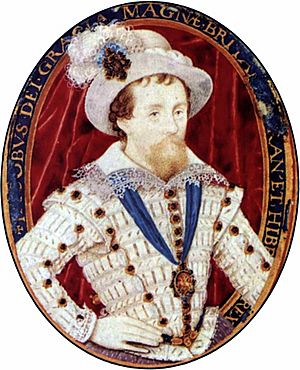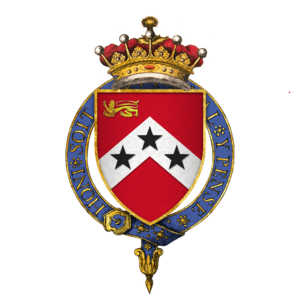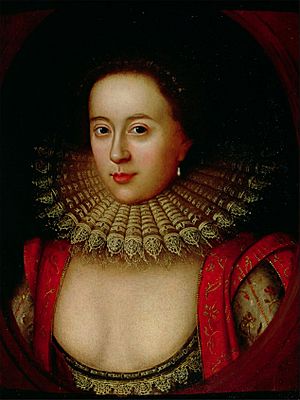Robert Carr, 1st Earl of Somerset facts for kids
Quick facts for kids
The Earl of Somerset
|
|
|---|---|

Portrait of Robert Carr, Earl of Somerset
by John Hoskins |
|
|
|
| Personal details | |
| Born |
Robert Kerr
1587 Wrington, Somerset, England |
| Died | 17 July 1645 |
| Nationality | Scottish |
| Spouse | Frances Howard |
| Children | Anne Russell, Countess of Bedford |
| Parents |
|
| Alma mater | Queen's College, Oxford |
| Occupation | |
| Known for | Poetry |
Robert Carr, 1st Earl of Somerset (around 1587 – 17 July 1645) was an important politician. He was a special friend and advisor to King James VI and I.
Robert Carr's Early Life
Robert Kerr was born in Wrington, England. He was the younger son of Sir Thomas Kerr and Janet Scott. His family was from Scotland.
Around 1601, Robert worked as a page for Sir George Home. A page was a young servant. During this time, he met Thomas Overbury in Edinburgh. They became good friends. They traveled to London together. Overbury soon became Carr's secretary. He helped Carr with his work. Overbury was like a mentor and advisor to Carr. He helped Carr become important in the royal court.
Becoming a Royal Favorite

In 1607, Carr had an accident. He broke his leg during a jousting match. King James VI and I was watching. The King liked Carr and took him under his wing. The King even taught him Latin. Soon after, the King made Carr a knight. He became Sir Robert Carr.
Carr became very close to the King. The King gave him a large estate called Sherborne. This estate used to belong to Sir Walter Raleigh. Raleigh had lost the property. Carr's influence grew. In 1610, he helped persuade the King to close Parliament. Parliament was questioning the King's Scottish friends.
On March 24, 1611, Carr was given a new title. He became Viscount Rochester. He also became a Privy Councillor. This meant he was a trusted advisor to the King.
Robert Carr's Marriage
In 1612, a key advisor to the King passed away. King James decided to manage the government himself. Carr took on many important duties. He acted as the King's secretary. However, Carr was not very experienced in government. He often relied on his friend Overbury for help.
Carr started a relationship with Frances Howard. She was the daughter of the Earl of Suffolk. Overbury did not trust the Howard family. He tried to stop Carr from marrying Frances.
To remove Overbury from the court, the Howard family tricked him. They made it seem like Overbury was disrespectful to the Queen. The King then offered Overbury a job as an ambassador. This job was in Russia. They knew Overbury would refuse. Refusing the King's offer was a serious offense.
Overbury did refuse the job. He wanted to stay in England with his friend. On April 22, 1613, Overbury was sent to the Tower of London. He died there five months later. His death was said to be from natural causes.
On September 25, 1613, Frances Howard ended her first marriage. The King supported her. On November 3, 1613, Carr received another title. He became the Earl of Somerset. On December 23, he was made Treasurer of Scotland. On December 26, Frances Howard and Robert Carr were married.



